In today’s video and article, we’ll be comparing Lulu Press with the Lulu Direct App. We’ll take a look at the services they provide, key advantages and drawbacks, as well as other important details – including how long it takes to publish your book on platforms like Amazon through Lulu’s Global Distribution. We’ll also cover the pros and cons of Shopify so that you have the details you need to decide which option is right for you.
Also, it may be helpful to know that I built my own Shopify website and I use the Lulu Direct App. So what I am sharing with you today is based off of research as well as personal experience. Alright, let’s take a look at how Lulu Press and the Lulu Direct App compare so you can decide which one is right for you.
Subscribe
Click to watch the full video or scroll down to read the full article. Additional videos and resources are linked at the bottom of the page.
But First, How Many Lulus Are There?
Before we dive right into our comparison, we should take a moment to clarify that there are several branches within Lulu – let’s briefly review each of them so you have an idea of what services they provide:
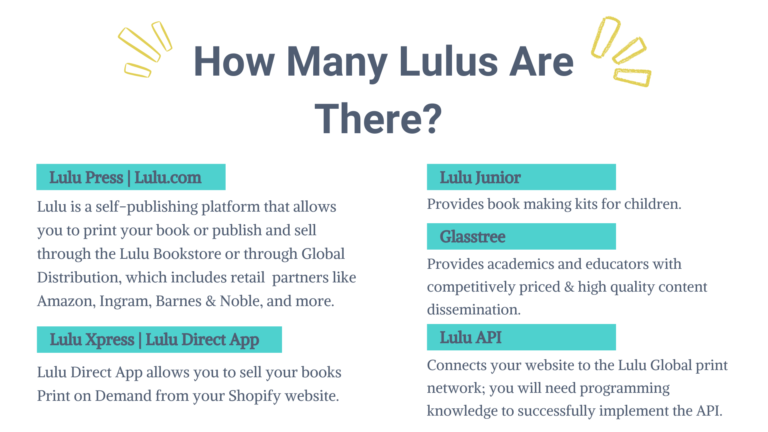
For clarification, Lulu Xpress encompasses Lulu Direct, which provides Lulu’s print on demand services. Also, the Lulu Direct App was formerly known as the Lulu Xpress App.
LULU PRESS
Benefits
Lulu Press is a self-publishing service that makes it easy to publish a book, planner or journal via their website, Lulu.com. Let’s dive into some of the key benefits of publishing with Lulu:
Lulu’s global distribution network– Lulu partners with companies like Amazon, Ingram Spark, and Barnes & Noble to provide global distribution for a fee. All in all, this global distribution service reaches over 40,000 retailers around the world. Ebooks published through Lulu.com are also distributed to partners like Amazon, Apple, Barnes & Noble, Google, and Libri.
Lulu’s online bookstore – Books published through lulu.com can also be listed on lulu’s online book store – there is a fee, though, that is applied at the time of sale. We’ll take a look at a breakdown of the fees for the book store and global distribution shortly.
High Quality Product – Lulu is commonly considered to be of higher quality than some competitors, like Amazon KDP.
Save time & money – listing your book on a marketplace potentially eliminates the need to build and maintain a website.
Benefit from platform algorithms – and, if your book has good reviews, the marketplace algorithms may help boost sales by listing your book on the 1st few pages that people see when searching for books, journals, planners etc.
No Upfront Cost – it is essentially free to publish your book; you only pay fees at the time of sale.
Drawbacks
Alright, here are a few of the drawbacks in using Lulu as a publishing service:
Distribution Fees – there are fees associated with distribution and those fees can be steep, leaving you with very minimal profit. These fees also apply to e-books, too.
Marketplace Marketing – marketplaces come with steep competition. Because of this, your marketing efforts could be lost as you drive traffic to your listing, only for customer to see other available options on the exact same page. And, if you get bad reviews, it could be detrimental to your sales.
Partner Quality – Lulu partners with companies like Amazon KDP to sell your book, which means that your book will be printed and shipped through them. This can be an issue because KDP, for example, has a reputation of damaging a certain percentage of book covers during their printing and shipping process. Also, I have received some feedback that their interior pages and binding are of lower quality as well. I don’t know how often this happens, and if its an issue that is consistent across all Amazon printers, or if quality is more of an issue at select locations. Having said that, it’s worth knowing because books, journals or planners that arrive to the customer damaged may lead to bad reviews, which, might have an impact on your ability to generate additional sales. For examples of journal cover, paper and binding quality check out this video: KDP vs Lulu vs Printify | Journal and Notebook Unboxing.
Partner Rules – you’ll have to adhere to the publishing rules for Lulu AND their partners.
Global Distribution Fees
Lulu’s global distribution service is extensive and covers a wide variety of retailers, however the fees are incredibly steep – potentially leaving you with minimal profit:
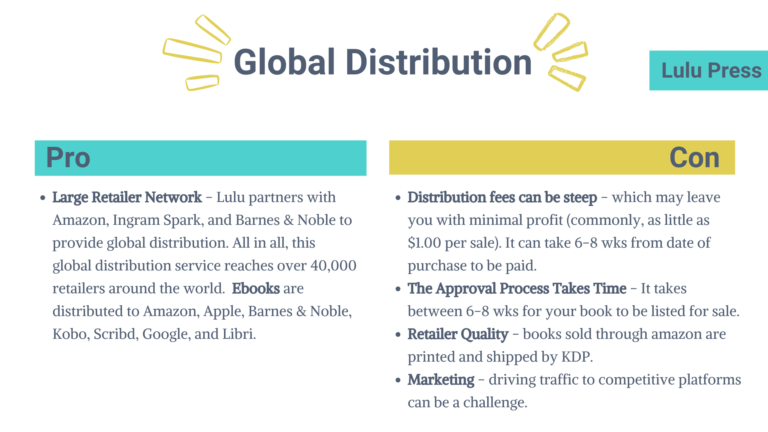
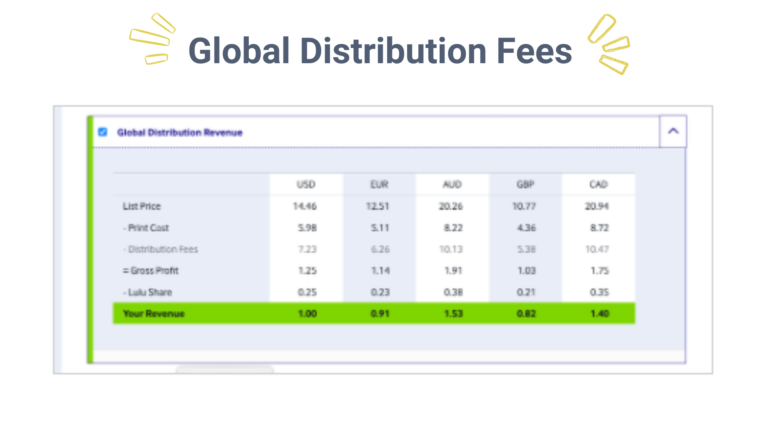
Lulu’s bookstore serves as a marketplace for books published through Lulu Press. Shown below is a breakdown of the costs associated with printing your book and Lulu’s share of the profits:
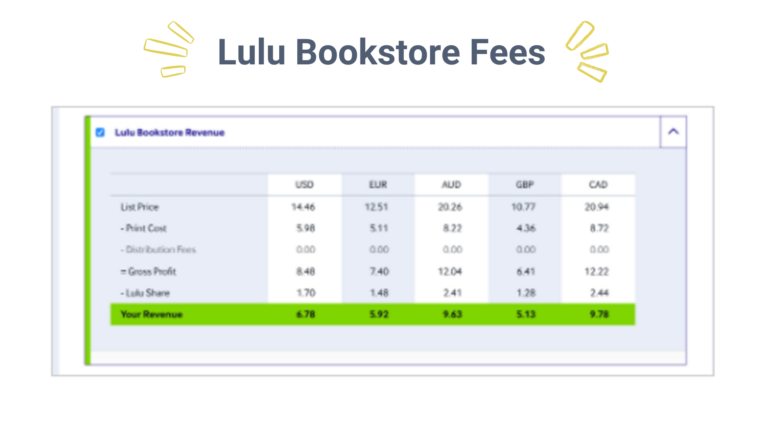
To see what Lulu’s bookstore has to offer, check out their bookstore at Lulu.com/shop.
ISBN Resources
When it comes to ISBNs, there are a few things to consider:
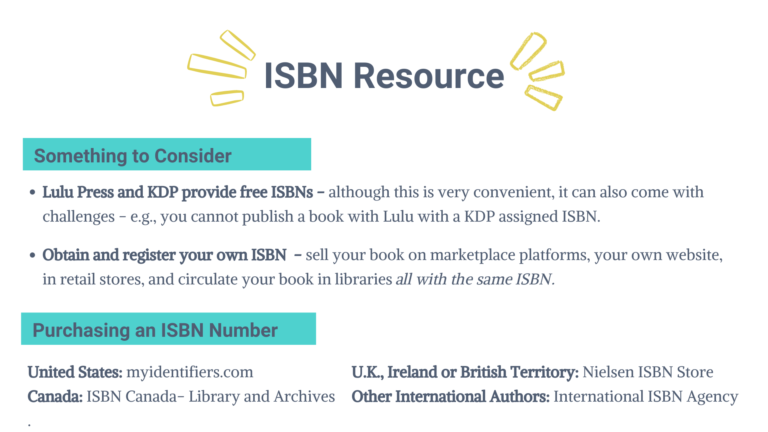
Although using an ISBN issued by KDP or Lulu is very convenient and free, it also comes with it’s own challenges – for example, you cannot publish a book with Lulu with a KDP assigned ISBN.
Another thing to know is that if you opt to purchase your own ISBN, then you can sell your book on marketplace platforms, your own website, in retail stores, and circulate your book in libraries all with the same ISBN.
Selling on Lulu Press
Publishing your book and selling your book with retailers will require an ISBN. However, you can sell your book from your own website or with the Lulu Direct App without an ISBN.
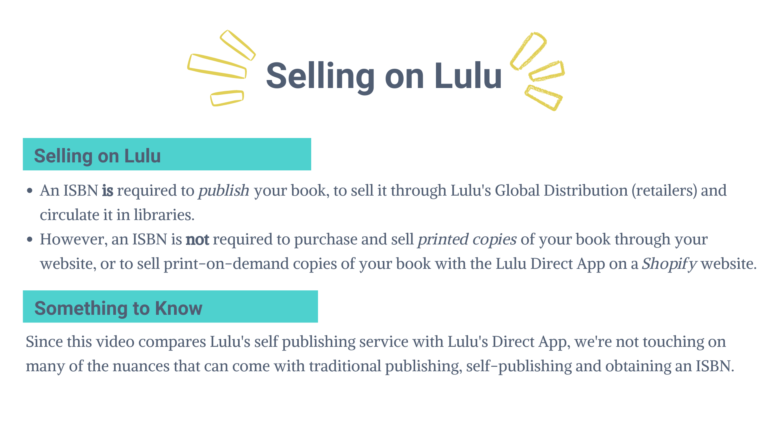
This topic is more nuanced than what is shown here, so I will link at the end of this article to some helpful ISBN resources that provide additional information.
Lulu Direct App with Shopify
Essentially, the Lulu Direct App was built specifically to integrate with Shopify websites, which allows customers to purchase your book, planner or journal directly from your website. Here are a few of the advantages of using the Lulu Direct App:
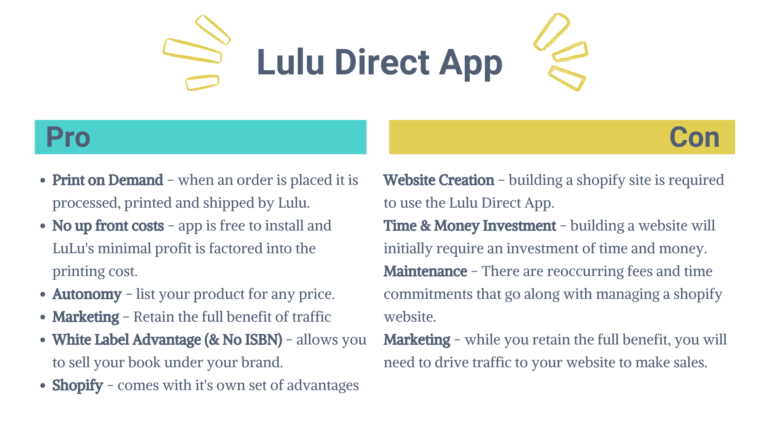
Benefits
Print on demand – when an order is placed it is processed, printed and shipped by Lulu – this means you won’t have to purchase, manage or handle inventory. And Lulu provides high quality print services & secure packing material as well, so your items won’t be damaged during shipment and delivery – both of these are important for your reputation as a seller.
No up front costs – this app is free to install and Lulu’s profit is factored into the printing cost, which is competitive with other self publishing companies and is only paid at the time of sale. An additional advantage with the Lulu direct app, is that you will retain all of your profit beyond the printing cost because the Lulu Direct app does not take a percentage of your profits.
Autonomy – list your product for any price – which may sound basic, but some self-publishing companies, like Amazon’s KDP, have rules around pricing that can create limitations. And this may impact you if you use Lulu’s global distribution, because you may be held to rules established by their partner retailers, like Amazon. With the Lulu direct app, you are free from those restrictions and you will retain more profit from sales.
Marketing – Retain the full benefit of all your marketing efforts – which is a huge advantage if you’re selling other products on your website.
White Label Advantage / No ISBN – The white label advantage means your books are printed with your branding and the packing slips will show the book was sold through your business. An ISBN number is not required with the lulu direct app either, which allows you to by-pass this step and sell your book, planner or journal without one.
Shopify – the lulu direct app integrates with shopify, and if you choose shopify as your website host, you’ll likely benefit from some of the advantages they offer.
Drawbacks
Website Creation – building a shopify site is required to use the Lulu Direct App, we’ll go more in depth on what this means, next.
Time & Money Investment – building a website will initially require an investment of time and money, and although the actual cost is determined on the choices you make along the way – the fact remains that no matter which way you go there will be a fair amount of up-front costs.
Maintenance – There are reoccurring fees and time commitments that go along with managing a shopify website.
Marketing – while you retain the full benefit, you will need to drive traffic to your website to make sales.
Shopify Overview
In order to use the Lulu Direct App, you’ll need to create a Shopify website – and although there are advantages to Shopify, there are also some considerable costs that can come along with it. Here is a snapshot of some of the foundational expenses you may run into:
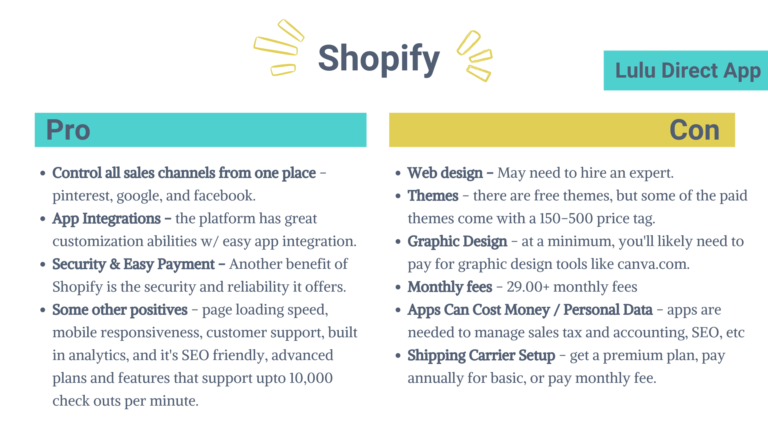
Benefits
Manage sales from one place – Shopify has a sales channel app for each social media channel – including pinterest, google, and facebook. Which means you can manage everything from products, inventory, customers and orders for all social media channels within Shopify. This makes it easy to track engagement for each channel all in one place.
App Integrations – Shopify is highly customizable. Largely because of how easily app integration is. This means that the you can easily add extra features and functionalities to your store – and some of the apps can go a long way in streamlining some of your business processes – like managing accounting and sales tax.
Security and Reliability – Another benefit of Shopify is the security and reliability it offers. Security is crucial for an online business for many reasons, but especially because it deals with the customer’s personal and financial information. There are other challenges, too – like having good website loading speed and stability – both these challenges are taken care of with Shopify’s hosting, which handles the behind the scene’s processes like upgrades and maintenance.
Some other positives – shopify websites come equipped with mobile responsiveness, great customer support, built in analytics and it’s built for SEO functionality, with room to grow into advanced plans and features that provide bandwidth to support upto 10,000 orders per minute.
Drawbacks
You will need to do some web building – which sounds complicated, and for some people it might be and they may consider hiring an expert. You might check out a shopify tutorial to see if it would be a good fit for you. I’ll link to a basic tutorial at the end of this article so you can see what goes along with building a shopify website.
Shipping carrier setup – this helps you streamline shipping and access discounted rates – which can make a big difference in your customer deciding to pay when they see the final total in check out. To access the shipping carrier rates, though, you’ll need to get a premium plan, or pay annually for basic plan, or pay a fairly hefty monthly fee. Although it has advantages, you don’t have to use the shipping carrier setup, so at the end of this article I will link to another video that shows an alternative shipping option that you can setup manually.
Themes – there are free themes that you can use to build your website, but if you want a more premium themes you will have to pay a one time fee between 150-350.
Graphic Design – even if you have graphic design skills, at a minimum, you’ll likely need to pay for graphic design tools like canva.com so you can access and create the images you need for your website graphics. If you’re not a designer, you may end up hiring someone to handle creating graphics for you.
Monthly fees – to use shopify you have to select a monthly plan, there is a “lite” version for about 9.99 / month, but the plan you’ll likely need will at least be the basic plan, which runs 29.00 / month.
Some Apps Cost Money and Some May Cost You Personal Data – apps are needed to manage sales tax and accounting, newsletter builder, SEO, etc., so it is inevitable that you will need to integrate them with your site. Some apps have a monthly fee, or an annual fee – and other apps are no cost but may collect your personal data instead.
No Global Distribution – if you use the Lulu Direct App it will not automatically connect your book to Lulu’s network of distributors or to their book store – which is also a “pro” because this means you will avoid paying the steep distribution fees.
Time Investment – there is a learning curve when creating and building your own website, especially if this is something completely new to you.
Lulu Print API
It is possible to connect lulu with a website other than shopify, but it requires intermediate level programming skills and a general understanding of web APIs.
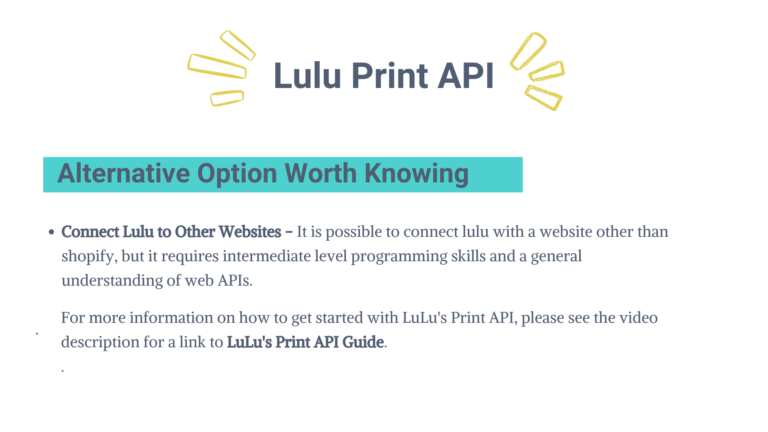
For more information on how to get started with LuLu’s Print API, please visit Lulu’s website or email their support team directly at automations@lulu.com.
Lulu Print API Guide: https://www.lulu.com/sell/sell-on-your-site/print-api
Links & Resources
LULU RESOURCES
Lulu Xpress Youtube Channel: https://www.youtube.com/channel/UCZXTbif2bO8DdgMIDLMZjwQ
Lulu’s Creator Revenue Guide (details of how to get paid): https://help.lulu.com/en/support/solutions/articles/64000262744-creator-revenue-guide
Lulu’s Global Distribution FAQs: https://help.lulu.com/en/support/solutions/articles/64000255456-global-distribution-faq
How to Publish a Book for Global Distribution: https://help.lulu.com/en/support/solutions/articles/64000255597-publishing-a-print-book-for-global-distribution
Setting Up Shipping for Lulu Direct Products: https://www.youtube.com/watch?v=EtIIG-A7QlY&t=0s
Lulu’s Bookstore: https://www.lulu.com/shop
ISBN RESOURCES
International ISBN agency: https://www.isbn-international.org/
(US) Bowker: https://www.myidentifiers.com/identify-protect-your-book/isbn/buy-isbn
(UK) Nielsen ISBN Store: https://www.nielsenisbnstore.com/
Canada Library and Archives: https://www.bac-lac.gc.ca/eng/services/isbn-canada/pages/isbn-canada.aspx
SHOPIFY RESOURCES
The Official Shopify Tutorial for 2021 – Setup Your Store The Right Way: https://www.youtube.com/watch?v=u-Qfdn44rB4&t=0shttps://www.isbn-international.org
Fiverr.com | can search and explore established and qualified professionals – including those who specialize in building and designing shopify websites.
Upwork.com | can search for shopify resources categorized by “projects” and “experts.” Example search results linked below:
Shopify Projects: https://www.upwork.com/services/search?nbs=1&q=shopify
Shopify Experts: https://www.upwork.com/search/profiles/?q=shopify&user_pref=2
thank You
Thank you for reading this article! Feel free to subscribe and check out other videos on our youtube channel.
Subscribe
Share this article:
————-
Affiliate Disclosure: This video description and/or blog may contain affiliate links, which means that if you click on one of the product links, I’ll receive a small commission. I won’t recommend anything that I haven’t verified or personally used myself.
Harley Byrd Design, LLC Disclaimer: The information provided in or through our Websites, Programs, Events, Videos, Tutorials and Services is for educational and informational purposes only and is made available to you as self-help tools for your own use. When using any material obtained from or through Harley Byrd Design, LLC, whether through in-person, webinars, social media, youtube, and otherwise in a variety of settings, including but not limited to individual and/or group programs, classes, workshops, events, tutorials, videos, seminars, consultations and/or trainings, you acknowledge that we are supporting you in our role exclusively as providing information, and in no other role. Additionally, the perspectives shared are based on my own experiences and do not represent any other person or entity. Recommendations provided should not be used in lei of or substituted for your own judgement and/or for advice by a business expert or medical professional.